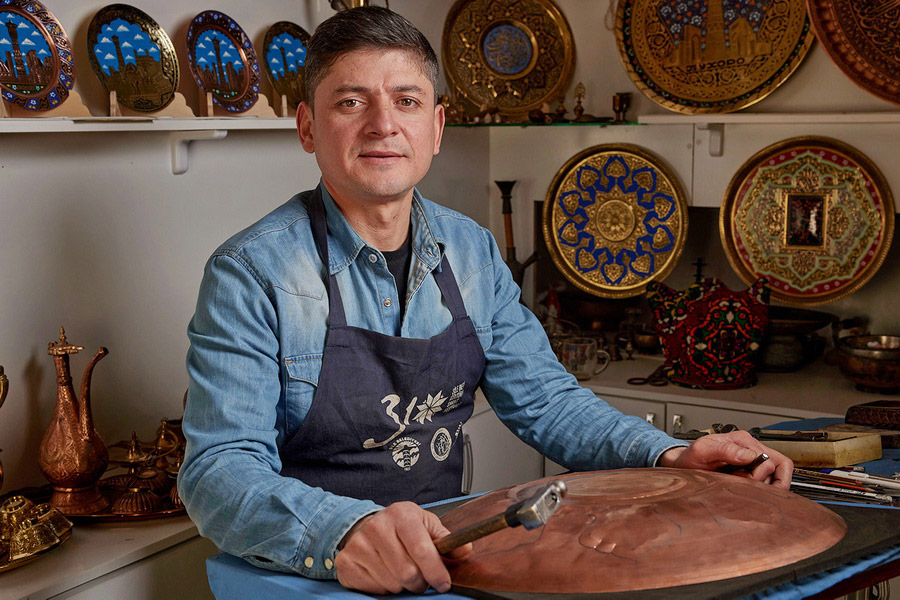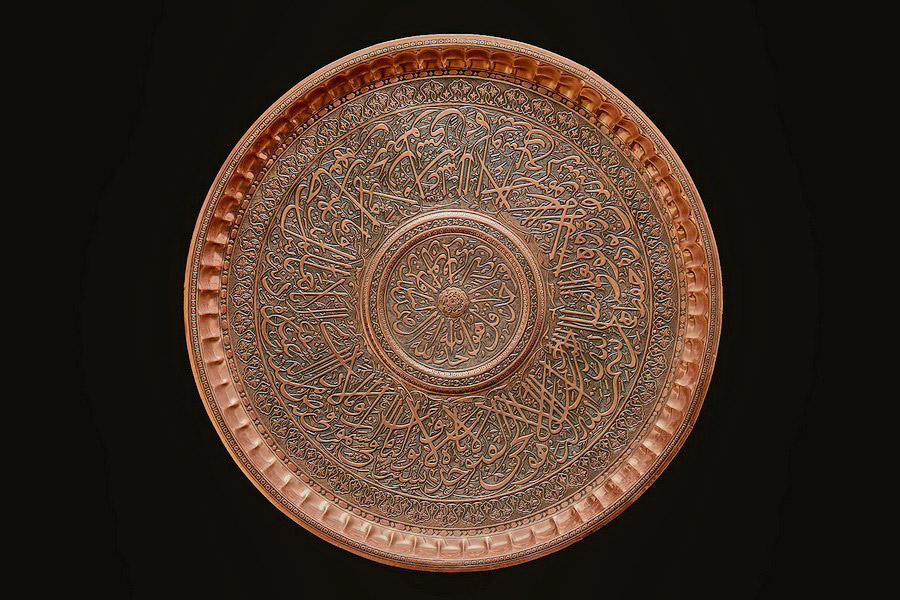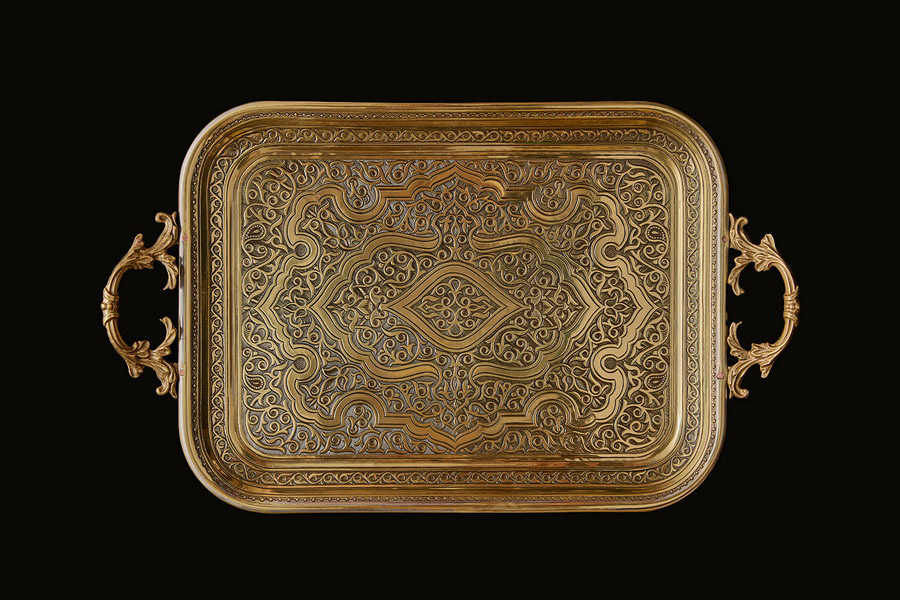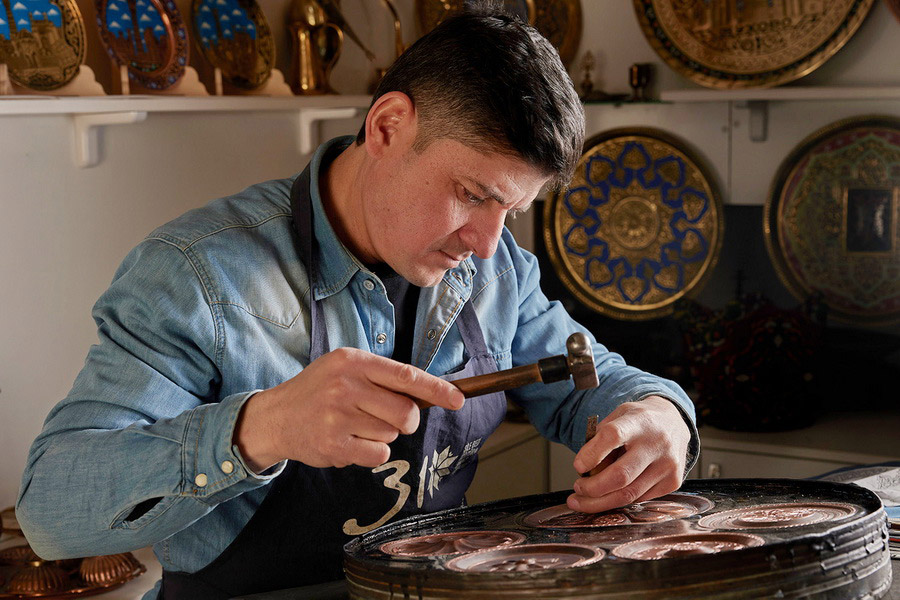
Photos Source: www.2022.homofaber.com
Jurabek Sidikov is a master metal engraver, a member of the Khunarmand association, and one of Uzbekistan's most renowned artisans, featured in the Homo Faber Guide.
Creative Path
Jurabek Sidikov was born in Bukhara into a family of artisans. His father was a carpenter, while his mother practiced metal engraving. From an early age, he was introduced to woodworking, but he chose to follow his mother’s craft. The artisan recalls that even as a child, he would visit his mother’s workshop and try to imitate the engravers at work.
Having learned the fundamentals of Uzbek metal engraving from his mother, Jurabek Sidikov continued his training under the guidance of Rahmat Ruziev. He began his professional career in 2000, and since 2004 he has been actively teaching, passing his knowledge to the next generation of metal engravers.
Today, he works in the Bukhara style of metal engraving, blending traditional methods with contemporary techniques. His works are regularly presented at exhibitions, festivals, and craft fairs across Uzbekistan. In 2025, he is scheduled to take part in a major international event – the Bukhara Biennale 2025.
The Art of Metal Engraving
The art of metal engraving is one of the oldest crafts in Uzbekistan and a significant form of applied art along the Silk Road. Traditionally, it was used to decorate tableware, weapons, and ornamental household items.
Several renowned regional schools developed across the country, including those of Bukhara, Samarkand, Khiva, and Kokand.
The Bukhara school of metal engraving reached its peak between the 15th and 19th centuries. This tradition is distinguished by:
- meticulous execution – designs are often richly detailed, with each element carefully crafted. Both recessed and raised ornamentation are used;
- the use of plant and geometric motifs – the famous Islimi plant pattern is especially prominent, along with calligraphic elements;
- a distinctive color and composition technique – typically combining a matte background with a polished design, creating a harmonious sense of symmetry and balance.
The Style of Jurabek Sidikov

The master follows the Bukhara tradition of working with artistic metal. In many of his pieces, he adheres strictly to traditional techniques, while in others, he prefers to experiment with both materials and ornamentation.
Jurabek Sidikov most often works with copper, brass, and nickel silver. The first two metals are considered classic choices among Bukhara masters of this Uzbek craft, while nickel silver is a more recent introduction. It offers a refined appearance at an accessible price, making it well suited for small yet striking items. Sometimes, the master combines different materials, such as copper and brass. Sidikov also works with precious metals – silver and gold. Such commissions are rare and crafted exclusively on individual request.
His range of products is wide: from miniature jewelry to large ceremonial basins. All his works are characterized by elaborate ornamentation, the elegance of plant motifs, and meticulous attention to detail. His painted decorative vessels, reminiscent of Aladdin’s lamps from oriental fairy tales, leave a particularly vivid impression.
In addition to household items, the master also creates decorative panels. One of the most significant works, according to him, was inspired by the art of Kazimir Malevich. The master incorporated elements of Uzbek art into the abstract style, achieving a truly unique result.

All processes of ornamentation, engraving, and polishing are carried out by the master himself, by hand, in accordance with Uzbek tradition. At the same time, he makes use of modern technologies – for example, a lathe and nitric acid. These tools allow him to streamline the process and improve the quality of the finished product.
In addition to creating his own works, the master also restores old metal tableware. Thanks to his talent, these items are given a new lease on life. In his interviews, Jurabek Sidikov notes that his inspiration comes from the world around him: nature, everyday objects, and the joy of communicating with loved ones.
Jurabek Sidikov's Workshop

The workshop is located in Bukhara, not far from the famous Chor-Minor Madrasah. It is open to visitors from 8:00 a.m. to 10:00 p.m.
A visit to Sidikov’s workshop offers insight into every stage of metalwork:
The first stage is the preparation of the metal sheet, which is initially shaped using a lathe.
The second stage involves creating a sketch of the ornament. The design is first drawn on paper, then carefully transferred to the metal surface. Jurabek Sidikov always uses unique, original patterns, noting that no two of his works are ever identical.
The third stage is embossing, carried out with a special tool known as a graver. This is a delicate and meticulous process – the depth of each line, which must match the original sketch, depends on the force and angle of each strike. To prevent the relief from deforming, a layer of bitumen is applied beneath the metal. This technique is relatively modern; traditional craftsmen worked without it.
The fourth stage is firing and cleaning. At this point, the piece acquires its characteristic artistic contrast – a darkened background set against raised, gleaming ornaments. While nitric acid is now used to achieve this effect, artisans in the past relied on natural fermentation products.
The fifth stage is polishing and varnishing. These final steps give the piece its smooth finish and glossy appearance.
Jurabek Sidikov gladly shares the history and techniques of this ancient Uzbek craft with visitors. Another highlight of the experience is the opportunity to speak with the craftsman in several languages – he speaks Uzbek, Tajik, Turkish, Russian, and English.
Visitor Information
- Address: 99, 100 Chupboz, Bukhara, Uzbekistan
- Phone: +99890 2988733
- Opening hours: everyday, 09:00 am – 10:00 pm

